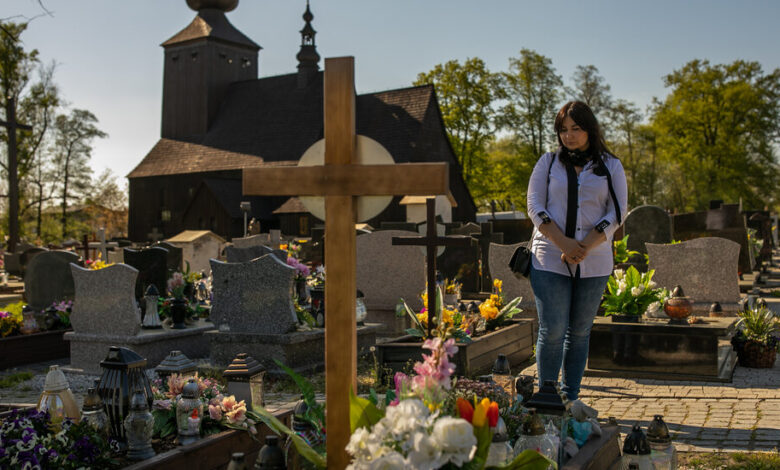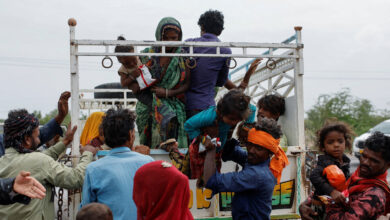Poland Shows the Risks for Women When Abortion Is Banned

PSZCZYNA, Poland — It was shortly before 11 p.m. when Izabela Sajbor realized the doctors were prepared to let her die.
Her doctor had already told her that her fetus had severe abnormalities and would almost certainly die in the womb. If it made it to term, life expectancy was a year, at most. At 22 weeks pregnant, Ms. Sajbor had been admitted to a hospital after her water broke prematurely.
She knew that there was a short window to induce birth or surgically remove the fetus to avert infection and potentially fatal sepsis. But even as she developed a fever, vomited and convulsed on the floor, it seemed to be the baby’s heartbeat that the doctors were most concerned about.
“My life is in danger,” she wrote in a string of distressed text messages to her mother and husband that was shared with The New York Times by her family’s lawyer.
“They cannot help as long as the fetus is alive thanks to the anti-abortion law,” she wrote only hours before she died. “A woman is like an incubator.”
Abortion has seized the United States’ attention anew with the prospect that, as early as this month, the Supreme Court could overturn Roe v. Wade, the decision that has made the procedure terminating a pregnancy legal for nearly 50 years. If Roe is overturned, half of American women stand to lose legal access to abortion.
Poland offers a glimpse of a country where abortion is already practically out of reach even in the gravest circumstances. It has long been a showcase of the volatility and vicissitudes of the abortion battles — and how the lives of women and their doctors are tossed about on shifting social and political tides.
The long battle over Poland’s 29-year-old ban on abortion has intensified over the past 17 months after the elimination of the last significant exception permitting the procedure: fetal abnormalities.
Since the exception’s elimination, deaths like Ms. Sajbor’s have been rare — one of three cited by abortion-rights advocates — but they have become a touchstone of grievance for those who say they demonstrate the risks to women posed by restrictive abortion laws.
Only one in 10 Poles support the stricter ban, which was enabled by a decision by the country’s highest court, dominated by judges loyal to a deeply conservative government. The rest of the population is roughly split between reverting to milder restrictions and legalizing terminations.
Today, Poland and Malta, both staunchly Catholic, are the only European Union countries where abortions are effectively outlawed.
The consequences in Poland have been far-reaching: Abortion-rights activists have been threatened with prison for handing out abortion pills. The number of Polish women traveling abroad to get abortions, already in the thousands, has swelled further. A black market of abortion pills — some fake and many overpriced — is thriving.
Technically, the law still allows abortions if there is a serious risk to a woman’s health and life. But critics say it fails to provide necessary clarity, paralyzing doctors.
“This law creates problems for doctors and patients,” Jan Kochanowicz, a doctor who is also the director of the University Clinical Hospital in Bialystok, the largest city in northeastern Poland, said in an interview. “There is no clear and straightforward answer to what constitutes a threat to a woman’s health and life. Doctors are afraid to make decisions.”
Defenders of the Polish abortion ban say these are extreme cases, caused not by the law but by doctors’ poor judgment.
“The law should not have a chilling effect because legislation on abortion when a woman’s health or life is in danger has not changed,” said Katarzyna Gesiak, the head of the center for medical law and bioethics at Ordo Iuris, a Catholic organization that lobbied for the new ban.
She agreed with opponents of the law that in its current form, the measure was “too general” and “too open to interpretation,” but her concern was that it still gave doctors too much latitude to perform abortions.
For abortion-rights supporters, clarity is less the issue than what they say has been a steady erosion of women’s autonomy since the abortion ban nearly three decades ago.
Just this month, the government required Poland’s central health care system to log pregnancies. Opponents called it a “pregnancy register” that could be used to track down illegal terminations.
“Once you start chipping away at the right to abortion, it’s hard to go back,” said Krystyna Kacpura, the president of the Federation for Women and Family Planning, or Federa, a Warsaw-based advocacy group. “We are now at a point where the risks to women’s physical and mental health have reached a new quality.”
Eliminating the Exceptions
Poland was once a destination for women seeking abortion.
Under Communism, the Catholic Church was marginalized and abortion legalized in 1956. Women were encouraged to work and granted sweeping reproductive rights that Western democracies embraced only decades later.
With abortions in Poland cheap and available practically on demand, women from all over Western Europe flocked there until well into the 1980s.
But that changed after the Communist government collapsed in 1989. Bowing to pressure from a newly assertive Catholic Church, which had supported the fight against Communism, the new Parliament proposed an abortion ban.
“No one knew at the time that the period of democratization would mean such backlash for women’s rights,” said Magdalena Sroda, a professor of ethics at the University of Warsaw. “It was a return to the discourse of traditional women’s roles as wives and mothers.”
It would become one of the defining culture wars of the new democracy for decades to come.
Women’s groups organized protests and signed petitions. Three in four Poles told pollsters at the time that they preferred the issue to be settled by a referendum, not by Parliament. The country was almost evenly split, with 53 percent in favor of the liberal status quo.
Even so, Parliament outlawed abortion in 1993 with three exceptions: danger to the health or life of the mother; rape or incest; fetal abnormalities.
After the ban, abortion swiftly moved underground. Doctors who had previously offered free terminations in public hospitals charged handsomely for terminations in private clinics. They offered gynecological services through classified ads with only a phone number and code words like “anesthesia” and “safe.” While legal abortions dropped to about a thousand a year, the actual number of terminations has stayed around 150,000, advocacy groups like Federa estimate.
“Everyone just made do,” Ms. Sroda said. “It was a bigger problem for women from smaller towns and villages, who did not have sufficient means for an abortion in a private clinic.”
Or, as Ms. Kacpura put it: “The ban has done a lot of things. What it hasn’t done is stop abortions.”
In 1996, a left-leaning Parliament passed a law restoring abortion rights only to have it struck down by the Constitutional Court a few months later. Citing Article 38 of the Polish Constitution, which protects “the life of every human being,” the court ruled that this included unborn life.
It was a harbinger of a broader shift in the abortion debate. Over the next two decades, public schools were obliged to teach children about “responsible parenthood” and “life in the prenatal phase.” Abortion became a taboo.
And an emboldened anti-abortion movement led by an alliance of Catholic organizations started lobbying to take away the most-used exception to the ban — fetal abnormalities — which had been used for almost all of the 1,000 legal abortions a year in Poland.
After the nationalist Law and Justice party won power in 2015, it embraced a near-absolute ban as part of its traditionalist agenda.
A wave of mass protests ensued. Legislation promoting the ban twice failed to pass in Parliament.
But it took effect anyway last year after Poland’s highest court intervened again.
Aborting a fetus with abnormalities, said the court’s president, Julia Przylebska, constituted “eugenic practices” and “a directly forbidden form of discrimination.”
In nearly three decades, there have been only a handful of abortion-related trials, and no doctors, women or activists have so far been convicted, Ms. Kacpura said. But the political climate has become progressively more intimidating, she and other activists say.
Underground abortions have largely stopped, forcing women to either import pills or travel to clinics just over the borders with the Czech Republic, Germany and Slovakia. Few now openly call for a full return to the liberal abortion rights of Communist times. The anti-abortion camp holds regular “family marches,” and billboard campaigns with outsize fetuses are a common sight across the country.
Though two exceptions to the Polish abortion ban remain, in practice, neither is used much: Rape victims require a certificate from a prosecutor, which takes time to obtain.
And as Ms. Sajbor’s case illustrates, “serious risk” to the mother’s health now competes with that to the fetus.
A Legal Trap
Ms. Sajbor, a 30-year-old hairdresser from the small town of Pszczyna in southern Poland, had been thrilled to be pregnant. She wanted a sibling for her 9-year-old daughter, Maja.
It was a shock when in her 14th week she learned that doctors suspected her fetus had Edwards syndrome, a serious chromosomal abnormality, and diagnosed other malformations. Instead of a nose, there was only cartilage. The feet were deformed. One heart chamber was dysfunctional.
Ms. Sajbor would have had an abortion if it had still been available in Poland, said her sister-in-law and close friend Barbara Skrobol. She even asked her local doctor about it last summer, but was told it was not an option.
At that point, “She looked into having an abortion abroad, but then her water broke,” Ms. Skrobol recalled in an interview.
When Ms. Sajbor was admitted to a hospital last Sept. 21, her mother and husband were not allowed to be with her because of Covid restrictions.
“I have to give birth to a dead baby,” she texted her mother. “Thanks to PiS I am lying down and waiting,” she wrote, referring to the governing party by its Polish acronym.
By the time the baby’s heartbeat had stopped and the doctors took Ms. Sajbor into the operating room the next morning, her limbs had already gone blue.
She died at 7:30 a.m.
When Ms. Sajbor’s family went public with her case in November, it prompted nationwide protests. It was the first time that a woman was thought to have died because of the abortion ban, Ms. Kacpura said. The hospital issued a statement afterward defending the doctors’ actions, saying that they had done “everything in their power” to save her life and had acted in accordance with Polish law.
The Polish Health Ministry responded to Ms. Sajbor’s death by issuing new guidelines reminding doctors that “they should not be afraid to take obvious decisions” if there were a threat to the woman’s life.
The Issue of Abortion Around the World
An evolving landscape. Women’s access to abortion continues to be debated around the globe. Here’s a look at the state of affairs in some countries:
But doctors and supporters of abortion rights say the law still leaves doctors wary of prosecution.
“The law has a chilling effect on doctors,” said Jolanta Budzowska, a Krakow-based lawyer who is representing Ms. Sajbor’s family and three others in negligence cases related to the new abortion law.
With the new law, said Dr. Kochanowicz, the hospital director, doctors “risk not only losing the right to practice, but also criminal liability.”
“All decisions are burdened with anxiety,” he said.
Since Ms. Sajbor’s death, other seemingly similar cases have emerged and are being investigated by the authorities.
In January, a 37-year-old woman carrying twins died after one of her fetuses had died and doctors did not remove it for seven days. The family accused the doctors of waiting for fear of harming the other fetus and being subject to possible prosecution.
Another woman, who was 19 weeks pregnant when her water broke, developed an infection and nearly died after doctors waited four days until her fetus’s heartbeat had stopped before removing it.
Threat of Prosecution
For women seeking abortions in Poland — and those trying to assist them — the routes have become treacherous. In February 2020, Justyna Wydrzynska, a prominent abortion-rights activist, got a panicked message from one of them.
The woman was in an abusive relationship. Her partner was watching her every move and would report her to the police if she went abroad for an abortion.
“Please help me,” she pleaded in a hushed phone call, “because I will no longer survive.”
For Ms. Wydrzynska, the case felt personal. In 2006, already a mother of three, she had been living with a violent husband and had an abortion herself.
“I know what it means to have to choose between the safety of your child and your own safety,” she said.
Though Ms. Wydrzynska works openly out of a headquarters in central Warsaw, the activists must carefully skirt around Poland’s anti-abortion law.
Under the law, a woman cannot be prosecuted for taking the abortion pills, but you can go to jail for helping someone else get them. So Ms. Wydrzynska normally provides only instructions on how to buy and use the pills.
But that day, the woman’s desperation compelled her to send her a package of pills. The woman’s partner, who was reading her text messages and emails, reported Ms. Wydrzynska to the police.
Ms. Wydrzynska is now standing trial and faces up to three years in prison. A verdict is expected in September.
Her team is part of a Europe-wide network called Abortion Without Borders that helps Polish women terminate pregnancies.
One challenge is to protect women from exploitation. “Abortion clinics are like petrol stations,” said Zuzanna Dziuban, a member of Ciocia Basia — or Auntie Barbara — a feminist collective in Germany. “The closer you get to the border, the more expensive they become.”
Like Going Back in Time
In a light-filled, sixth-floor clinic in a leafy corner of central Berlin, Dr. Sabine Müller, who has been a gynecologist for more than 25 years, reserves half of her abortion slots for Polish women every week.
“The demand has gone up,” Dr. Müller said, sitting in her consulting room one recent morning. “And the stories have gotten worse.”
“We have a lot of Polish women with cancer who are told, ‘No, we can’t give you cancer treatment because you’re pregnant and it could hurt the baby,’” Dr. Müller said.
Recently, a 39-year-old woman with metastasizing bronchial cancer came for an abortion after her Polish doctor had delayed her chemotherapy for six weeks.
“Cancer spreads extremely fast during pregnancy,” Dr. Müller said. “A six-week delay is almost a death sentence.”
Since last year’s ban on abortions of fetuses with abnormalities, the demand for late-term abortions has surged, too.
About 80 Polish women a year used to visit Heemstede, an abortion clinic near Amsterdam that specializes in late-term abortions, which are allowed in the Netherlands until the 24th week. Last year, of 3,000 abortions performed there, 400 were provided to Polish women.
“We used to be a clinic for unwanted pregnancies,” said Femke van Straaten, the clinic’s manager. “The Polish women that come here now are a very different group.”
Many wanted to have a child and were heartbroken to discover well into their second trimesters that their fetuses had serious defects.
To comfort Polish patients, the clinic’s staff is learning Polish, and the clinic started cooperating with the local cemetery, which runs a memorial garden where, once a month, ashes of fetuses are scattered.
When Heemstede opened in 1971, the Dutch justice minister tried to shut it down, and women’s groups routinely clashed with riot police officers just outside its gates.
Now, anti-abortion protesters are showing up again.
“It’s like going 50 years back in time,” she said.




